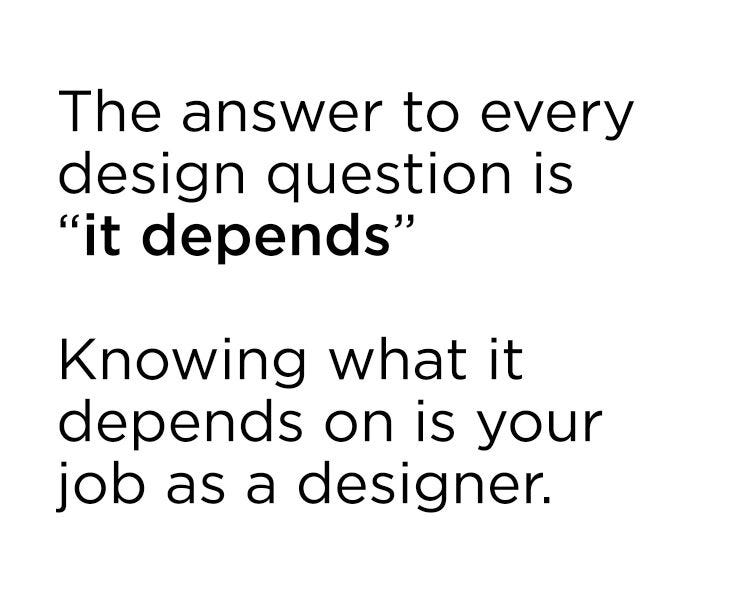There’s a genre of professional content I’ve come to recognize instantly. It begins with confidence, proceeds with certainties, and ends with a prescription. Or worse, “Comment [enter random term]”.
Here’s the method.
Here’s what works.
Here’s how to win.
And every time I see it, a small part of me cries inside.
Not because I think they’re wrong, but because I’ve been inside enough organizations to know that none of this unfolds in a vacuum. Advice that sounds brilliant on a whiteboard often dissolves the moment it hits budget constraints, team friction, or the fifth tool no one dares deprecate.
So when people ask me, “What’s the right way to do this?” my honest answer is:
It depends. And that’s not a cop-out, but I did copy it off of Luke Wroblewski. In all honesty, it’s the beginning of the real work.
There is no single method. Just methods that work in a specific context, for a while, until something changes.
That’s not exactly a bestselling title. But it’s the only claim I can stand behind.

Context is the story.
You can’t copy-paste someone else’s Martech success. You don’t inherit team readiness by buying the same stack. You don’t get orchestration just because you licensed a Journey Builder. And yet, we keep getting articles and keynote slides that flatten all this into clean stages and tidy diagrams.
What’s missing is a willingness to stay in the ambiguity. To admit that Martech success is often shaped less by tools than by timing, culture, tradeoffs, and inertia. And that what worked once may not work again.
When I wrote the CDP Reboot, I wasn’t mapping the future of the category. I was holding up a mirror to the chaos many teams live through, and still somehow function within.
With the Contextual CDPs series, I wanted to explore how the same stack can produce radically different outcomes depending on what surrounds it. Things like artificial intelligence, org structures, incentives, data policies, leadership habits.
Now, in the Agentic AI in Martech series, I’m wrestling with a different kind of complexity → delegation. Not just which team owns what, but how decision-making flows when AI enters the loop, quietly steering systems in ways humans barely trace.
Each of these projects started from a similar impulse:
Not to define a new method, but to ask whether we’re even asking the right questions.
What I believe, for now
I believe there’s no universal method, and I have always been outspoken about this.
Only moments of fit, where the structure, team, tooling, and goals line up just enough to create movement.
And that movement is usually short-lived. Something shifts, someone leaves, another platform launches, and we’re back to adapting.
But don’t despair, my Martech friend. This is not a sign of failure or incompetence. That’s what it means to work in a complex system.
So rather than handing out answers, I try to play the role of Leonardo Di’Capprio in Inception, and plant ideas such as:
What friction are you learning to tolerate instead of solve?
What kind of control are you seeking, and who benefits from it?
Which team’s pain is loudest right now, and is that distorting your priorities?
These aren’t questions you see or think of every day, but they need to be there in the back of your mind. They’re the kind that might lead you to a version of success that’s actually your own.
What comes next
For now, I’m still writing. Still exploring.
The Agentic AI in Martech series is halfway through.
A series on Multi CDP setups will follow soon.
Both are rooted in the same hesitation that shaped this post. Not just to describe what’s happening, but to resist the urge to pretend it’s simple.
And I get it. Certainty is easy to sell. But too much of it is leaving teams with beautiful decks and broken implementations.
So no, I won’t give you the method.
But I will give you questions.
I’ll show you what I’ve seen.
And I’ll be honest about what’s still unclear, even to me.
Because that’s the only kind of Martech advice I trust.
👥 Connect with me on LinkedIn:






